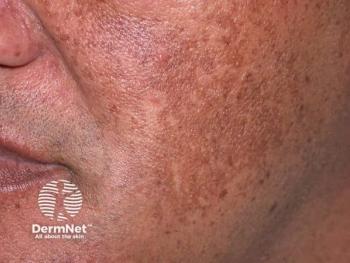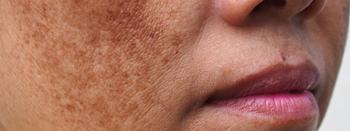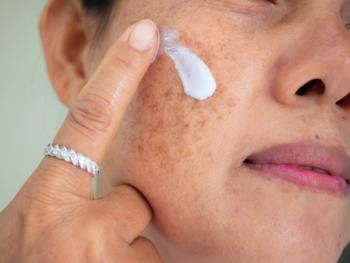
Laser-assisted delivery of tranexamic acid for melasma
Findings from two recent pilot studies suggest 1927 nm fractional thulium fiber laser-assisted topical tranexamic acid delivery is a safe, effective melasma treatment option.
Findings from two recent pilot studies suggest 1927 nm fractional thulium fiber laser-assisted topical tranexamic acid delivery is a safe, effective melasma treatment option.
A theory of how melasma occurs suggests ultraviolet light increases plasmin activity in keratinocytes, according to the study “
“… which has led to the investigation of tranexamic acid for treatment melasma, since it possesses anti-plasmin properties. The use of laser-assisted drug delivery can also increase the uptake of topical medications,” wrote the study’s author, from the Laser & Skin Surgery Center of New York, New York.
Clinician authors treated 10 melasma patients with five full-face low-energy, low-density 1927 nm fractional thulium fiber laser treatments. They set the LaserMD (Lutronic) laser to Random Mode with a 4W to 5W output power, 2mJ to 8mJ fluence and using 2 to 8 passes, according to the paper.
Immediately after laser treatment, they applied topical tranexamic acid and instructed patients to apply the tranexamic acid topical twice daily for the next seven days.
The authors reported on patients’ clinical outcomes, quality of life and satisfaction. Seven of the initial 10 melasma patients enrolled completed the study. All were female and had Fitzpatrick skin types II, III and IV.
They found Melasma Area Severity Index (MASI) scores improved an average 1.1 at 30 days, 3.5 at 90 days and 2.5 points at 180 days. The average MASI score at baseline was 10.6, with the biggest improvement from treatment occurring at 90 days. Three of the seven patients experienced melasma recurrence and a worsening of their MASI score by day 180.
Investigators and subjects also used the 3-point Global Aesthetics Improvement Scale to grade clinical improvement at follow ups. Investigators rated improvement from baseline in five subjects at the 30- and 90-day follow up visits and six subjects at 180 days. They rated the others as having no clinical change. Using the Global Aesthetics Improvement Scale, six subjects reported improvement at 30 and 90 days and seven, 100%, saw improvement from baseline at 180 days.
Patients reported an average 9.6-point improvement on the Melasma Quality of Life Scale at 30 days. A few patients reported other positive changes in their facial skin, from radiance to improvements in skin texture and tone.
At 30 days, five subjects were satisfied with treatment and would recommend it to their friends and family for melasma.
Subjects experienced predictable side effects of transient roughness, dryness and itching. All were mild and resolved without treatment.
The authors wrote that this study, which is limited by the small number of subjects, suggests that combining low-energy, low-density 1927 nm fractional thulium fiber laser and tranexamic acid can improve melasma patient outcomes. But large-scale studies with a split face design would better assess how this combination approach compares to tranexamic monotherapy.
Authors of another paper, “
In the split-face study, researchers from Thailand and the Philippines compared fractional thulium laser alone with laser-assisted delivery of topical tranexamic acid. Patients in the study were predominately female with a mean melasma duration of 6.9 years. They treated the 46 adults with four weekly fractional 1927 nm thulium laser treatments on the full face, immediately followed by tranexamic acid topical treatment on one side and saline solution on the control side.
They reported on patients using the Melanin Index, modified MASI and patient self-assessment scores at baseline, weeks 1 and 3, and at 3 and 6 months after the final treatment.
They found highly significant improvement from the combination maintained until 3 months.
“High significance was seen in the [Melanin Index] for both sides at the 1st-month assessment, and although very high significance was maintained for [tranexamic acid] at 3 months post final treatment… significance decreased for the control side…,” they wrote.
There was some reversal of improvement after 3 months and to 6 months after treatment on the tranexamic acid side, but the 6-month results from the 29 patients still in the study continued to show significant improvement from baseline in some measures.
“These findings thus support the possibility of a treatment regimen for recalcitrant melasma patients involving 4 weekly sessions of topical [tranexamic acid] with [fractional thulium laser], with a repeat regimen performed every 3 or 4 months,” they wrote.
References:
1. Wang, JV, Christman, MP, Feng, H, Ferzli, G, Jeon, H, Geronemus, RG. Laser‐assisted delivery of tranexamic acid for melasma: Pilot study using a novel 1927 nm fractional thulium fiber laser. J Cosmet Dermatol. 2020; 00: 1– 5.
2. Wanitphakdeedecha, R., Sy-Alvarado, F., Patthamalai, P. et al. The efficacy in treatment of facial melasma with thulium 1927-nm fractional laser-assisted topical tranexamic acid delivery: a split-face, double-blind, randomized controlled pilot study. Lasers Med Sci 35, 2015–2021 (2020). https://doi.org/10.1007/s10103-020-03045-8
Disclosures: Lutronic funded and supported the study in the Journal of Cosmetic Dermatology and provided the topical products used in it. No conflicts reported in the Lasers in Medical Science paper.
Newsletter
Like what you’re reading? Subscribe to Dermatology Times for weekly updates on therapies, innovations, and real-world practice tips.

















